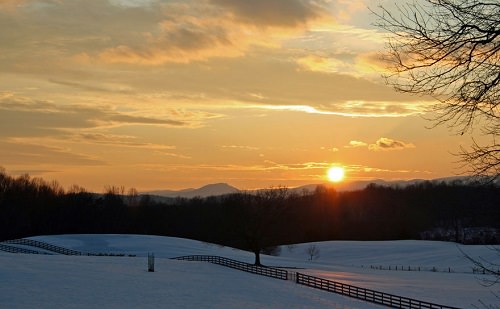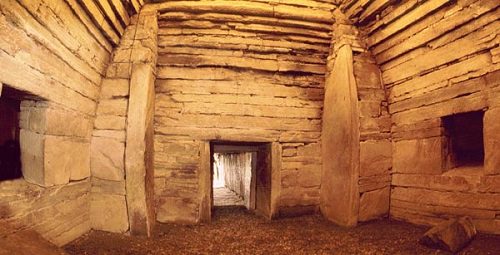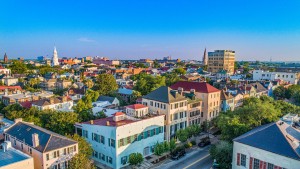Honoring the Winter Solstice is an ancient tradition, perhaps the oldest one humans have. For the people who lived thousands of years ago in Britain, it was a celebration of the return of light after months of darkness. Occurring in deep midwinter, on the shortest day and longest night of the year, the solstice was seen as the harbinger of renewal and hope. It was a spiritual experience. With extraordinary intention these people built massive and mysterious structures in which passageways allowed the light from the sun to enter exactly on the solstice. How they did this is well-known today, and the ritual comes to us across nearly six millennia.
Three megalithic sites in the U.K. remain as a testament to the powerful purpose and beliefs of the ancient inhabitants: one at Newgrange in northeastern Ireland, one at Maeshowe in Scotland, and the most familiar of all, Stonehenge in Wiltshire, England.
You can visit Newgrange and Stonehenge and participate in ceremonies welcoming the Winter Solstice just as it was done over 5,000 years ago. At Maeshowe, a webcam has been set up to allow you to participate in the event on December 21, 2014, from any place in the world.
Newgrange
Newgrange was built in Ireland in 3200 B.C. It is shaped in a high mound rising up from an isolated field in the Boyne Valley in County Meath. This mound contains tunnels and channels. It has what is called a “roof-box” made of specially aligned stones over the entrance. On the Winter Solstice, at first light, the sun sends a beam of light through this roof-box. The light moves steadily up a 62-foot passage and into the central chamber. When the sun has risen fully, the entire chamber is illuminated. This event doesn’t happen at any other time of the year. The reason Newgrange was created in Neolithic times was to honor the Winter Solstice.Access into Newgrange for this remarkable event is allowed every year through a lottery carried out by the “Brú na Bóinne Visitor’s Centre.” A special post box is made available for applications in person or by regular mail. Only 50 respondents are accepted, drawn randomly by local school children. For the upcoming Winter Solstice 2014, 30,532 applications were submitted! Applications for the 2015 event are required by September 25, 2015.
However, if you do not win the lottery for the actual solstice event, you are still allowed to enter Newgrange in groups of fifteen after the sun has risen and no longer sends light into the passageway. You are led into the center chamber and stand in absolute darkness under its high dome. The effect carries you across millennia, as if time did not exist.
Maeshowe
Photo: www.maeshowe.co.uk
Maeshowe, on the distant isle of Orkney, Scotland, is a Neolithic chambered cairn and passage grave built around 2800 B.C. It rises as a grass-covered hill twenty-four feet above an isolated field much like Newgrange (which lies 530 miles to the south across the North Channel). This structure, too, is filled with a maze of passageways and chambers that become illuminated by sunlight during the Winter Solstice. It holds an atmosphere of mystery and wonder and curiosity. What led the small community in this cold outpost to construct such a monument? What did it symbolize to its creators?
The interior of Maeshowe is made of huge stones set up in lintels with symmetrical rectangular openings everywhere. The whole plan of it is meticulous. The effect is profound, for it signals death and life at once. The Winter Solstice is an end and a turning point. Moments after it is done, the sun begins to move in its six-month journey to midsummer.
A webcam has been set up at Maeshowe for the period from November 2014 through February 2015. You can visit www.maeshowe.co.uk to view a live feed (GMT) of the chambers, see webcam locations, view videos from previous years of the Winter Solstice, and learn more about Maeshowe.
The live feed is scheduled for December 21, 2014, though the link Home page does indicate that Orkney has been inundated lately 333 with days of thunder and lightning storms and heavy snow. The staff expects to be able to ensure broadcast if at all possible at sunrise.
Stonehenge
Most people have heard of or visited Stonehenge, a 5,000-year-old massive circle of stones set on Salisbury Plain in Wiltshire, England. The site has inspired legends and folklore for centuries. No one yet can fathom how the builders raised the giant sarsen pillars or placed the lintels above them. We don’t really have any knowledge of the purpose of Stonehenge, though some feel convinced astronomy played a role, or the cycle of seasons and crops, but still, there is no way to know. Many others claim the intention of the circle had a spiritual meaning.
It has been determined that the smaller stones that create the inner ring were taken from the Preseli Mountains in Wales, over 200 miles away. There are those who say the Preseli Bluestone has a shamanic energy drawn from the Merlin of ancient legends!
Stonehenge is carefully aligned on a sight-line that points to the winter solstice sunset. The sun’s rays align with two significant stones: the central Altar stone and the Slaughter stone.
Still, visitors from around the world will gather at Stonehenge early in the morning of December 22, 2014, to mark the Winter Solstice. The reason is that in 2014 sunrise is celebrated just after 8 a.m. on December 22. Why not the 21st? This is unique to Stonehenge because the celebration at Stonehenge is not fixed to a specific calendar date but aligned with the solar year. (It also might be because sunset can be very cold out on the windswept plain…) After many decades of restoration, in which the fallen stones were reinserted into their assigned slots in the ground, Stonehenge was brought into the true state it had millennia ago.
More: 10 Lesser Known Ancient Ruins in Europe
Many sites like these three megaliths were built around the same time in other parts of the world. They all contain in their shape and solidity an identity and affirmation for the people who created them. For us, making a connection with our ancient past is, in a way, making a connection with ourselves. The people who lived thousands of years before us show an attention and caring and reverence for things we also understand in much the same way. For us, too, the entrance into the dark of winter is a rite of passage, and our relief at seeing the days grow longer is a kind of faith in the journey of life restored.
What does midwinter mean to you? Does the symbol of the Winter Solstice hold mystery and enchantment for you? Do you feel that the ritual of honoring the passage from dark into light is a way for us to allow the rhythms of life to guide us, to ground us in the vitality of who we are?










